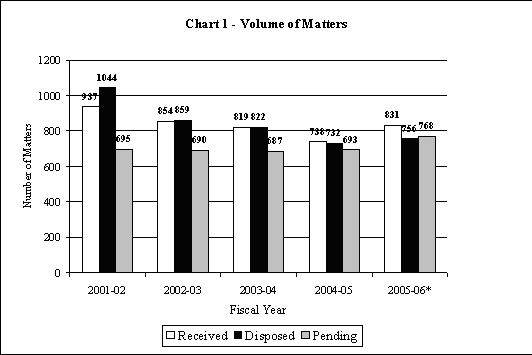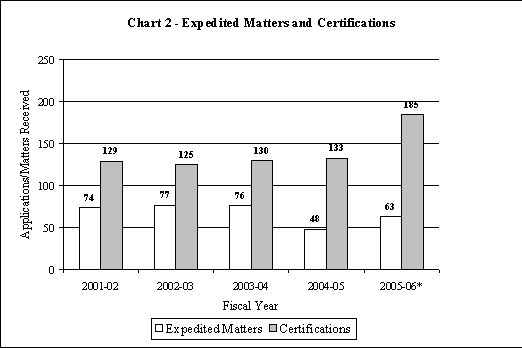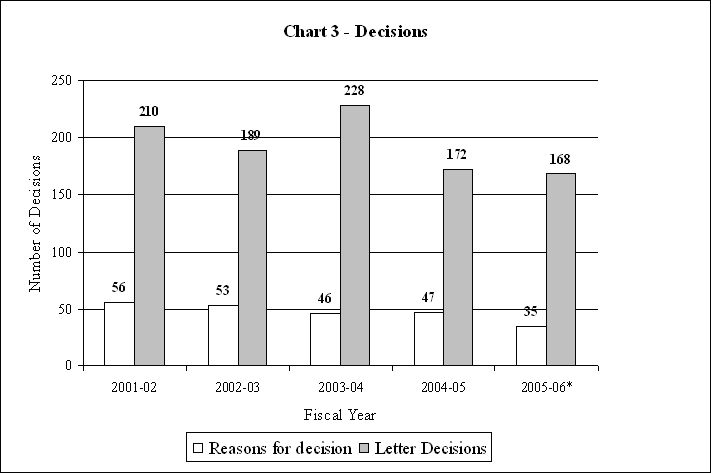Common menu bar links
Breadcrumb Trail
ARCHIVED - RPP 2006-2007
Canada Industrial Relations Board
 This page has been archived.
This page has been archived.
Archived Content
Information identified as archived on the Web is for reference, research or recordkeeping purposes. It has not been altered or updated after the date of archiving. Web pages that are archived on the Web are not subject to the Government of Canada Web Standards. As per the Communications Policy of the Government of Canada, you can request alternate formats on the "Contact Us" page.
SECTION I – Overview
1.1 Message from the Chairperson
 I am
pleased to present to Parliament and to Canadians the 2006-07 Report on Plans and Priorities for the Canada Industrial Relations
Board (CIRB). I am committed to ensuring that the Board achieves its mandate of contributing to and promoting a harmonious
industrial relations climate in the federally regulated sector as effectively and efficiently as possible.
I am
pleased to present to Parliament and to Canadians the 2006-07 Report on Plans and Priorities for the Canada Industrial Relations
Board (CIRB). I am committed to ensuring that the Board achieves its mandate of contributing to and promoting a harmonious
industrial relations climate in the federally regulated sector as effectively and efficiently as possible.
The demand for CIRB services continues to be high and many cases are extremely complex due to structural changes in most federally regulated industries. This trend has characterized the Board's case volume since the enactment of changes to the Canada Labour Code in 1999. The underlying challenge of the Board is to effectively utilize its expertise and resources to provide sound and timely labour relations decisions reflecting the needs of the community in this continually changing environment.
The CIRB has undertaken a number of initiatives in 2005-06 to improve its rate of case disposition. In addition to enhancing certain general internal operational processes, the Board, in consultation with its Client Consultation Committee, adopted new measures for the processing of particular types of cases, such as applications for certification and duty of fair representation complaints. In 2006-07, the Board will review the processing of applications for reconsideration and should implement more effective measures for their treatment by the end of the fiscal year. Furthermore, the CIRB is close to completing the renewal of its information technology systems, which should also contribute to the Board's efficiency in dealing with its caseload in the future. The effectiveness of the new measures that were implemented in 2005-06 will be monitored in 2006-07 and appropriate adjustments will be made when required. The Board, in consultation with the Client Consultation Committee, will continue to look at various other means of improving the Board's efficiency and will provide options in the new fiscal year.
In light of the continuing challenge to reduce its backlog and to manage its historically high volume and complex workload, the CIRB intends for the year ahead to keep its focus on the fulfilment of its current mandate with an emphasis on the reduction of the volume pending matters. Toward this end, I am confident that the new case processing measures we have adopted will have a noticeable effect, and I remain committed to finding new opportunities to further increase the productivity of the CIRB and gain greater efficiencies.
Warren R. EdmondsonChairperson
1.2 Management Representation Statement
I submit for tabling in Parliament, the 2006-2007 Report on Plans and Priorities (RPP) for the Canada Industrial Relations Board.
This document has been prepared based on the reporting principles contained in the Guide for the Preparation of Part III of the 2006-2007 Estimates: Reports on Plans and Priorities and Departmental Performance Reports:
- It adheres to the specific reporting requirements outlined in the TBS guidance;
- It is based on the Board's approved Program Activity Architecture structure as reflected in its MRRS;
- It presents consistent, comprehensive, balanced and reliable information;
- It provides a basis of accountability for the results achieved with the resources and authorities entrusted to it; and
- It reports finances based on approved planned spending numbers from the Treasury Board Secretariat in the RPP.
Title: Chairperson
1.3 Raison d'être
The Canada Industrial Relations Board (CIRB) is an independent, representational, quasi-judicial tribunal responsible for the interpretation and application of the Canada Labour Code (the Code), Part I, Industrial Relations, and certain provisions of Part II, Occupational Health and Safety. It was established in January 1999, to replace the previous Canada Labour Relations Board (CLRB), through amendments to Part I of the Code.
The adjudicative team of the Board is currently composed of the Chairperson, five Vice Chairpersons, three part-time Vice-Chairpersons and two full-time and six part-time members – all of which are Governor in Council (GIC) appointments. It may be of interest to note that the Code requires that the Chair and Vice-Chairs must have experience and expertise in industrial relations, and that members are to be appointed upon recommendation by the Minister of Labour after consultation with the organization's representative of employees or employers.
The CIRB has jurisdiction in all provinces and territories with respect to federal works undertakings or businesses in the following sectors:
- Broadcasting
- Chartered banks
- Postal services
- Airports and air transportation
- Shipping and navigation
- Inter-provincial or international transportation by road, railway, ferry or pipeline
- Telecommunications
- Grain handling and uranium mining and processing
- Most public and private sector activities in the Yukon, Nunavut and the Northwest Territories
- Band Councils and some undertakings of the First Nations on reserves
- Certain Crown corporations (including, among others, Atomic Energy of Canada Limited)
This jurisdiction covers some 1,000,000 employees and their employers, and includes enterprises that have an enormous economic, social, and cultural impact on Canadians from coast to coast. The variety of activities conducted by the federally regulated sector, as well as its geographical spread and national significance, contribute to the uniqueness of the federal jurisdiction and the role of the CIRB, and pose particular challenges for the Board's work.
The Board has established a series of strategic objectives in support of its mandate, which include to
- conduct all its processes in accordance with the standards of the Code;
- seek solutions to labour relations problems by determining the cause and nature of conflict and by applying the appropriate dispute resolution mechanisms, including fact-finding, mediation and adjudication;
- conduct its activities in a timely, fair and consistent manner;
- consult its clients on its performance and on the development of the Canada Industrial Relations Board Regulations, 2001 (the Regulations), policies and practices;
- promote an understanding of its role, processes and jurisprudence through continuous client contact and a variety of information dissemination methods (Web-based and conventional publishing, Board presentations at various forums, 1-800 information request line, etc.);
- conduct its business and manage its resources in a manner that is fiscally sound, in accordance with the Financial Administration Act and the policies and directives of the central agencies of government;
- ensure continuous interaction with those utilizing Board services through meaningful communication and complaint processes.
1.4 Summary Information
| Reason for Existence – The mandate of the Canada Industrial Relations Board is to contribute to and promote a harmonious industrial relations climate in the federally regulated sector through the impartial, effective and appropriate administration of the rules of conduct that govern labour and management in their representational and bargaining activities. In achieving this strategic outcome, the Board provides effective industrial relations solutions for the Canadian labour relations community in a fair and timely manner. |
Financial Resources
|
2006-2007
|
2007-2008
|
2008-2009
|
|
($ thousands)
|
($ thousands)
|
($ thousands)
|
|
12,366
|
12,396
|
12,396
|
Human Resources
|
2006-2007
|
2007-2008
|
2008-2009
|
|
FTEs
|
FTEs
|
FTEs
|
|
117
|
117
|
117
|
Departmental Priorities
| Activity/Initiative | Type |
| Accelerated reduction of the number of backlog cases | Ongoing |
| Reduction of average case disposition time | Ongoing |
| Monitoring and fine-tuning of new certification application process and disposition | Ongoing |
| Monitoring and fine-tuning of new duty of fair representation complaint process and disposition | Ongoing |
| Review of reconsideration application process and disposition | New |
| Client consultations | Ongoing |
SECTION II – Operating Environment
The CIRB's operating environment continues to be challenging. Changes to the Code (Part I) enacted in 1999, which gave the CIRB additional powers and responsibilities, have had a significant impact on its workload. Furthermore, the continued evolution of the labour relations climate in Canada – influenced by heightened competition, the globalization of markets, technological change, the volatility of national and international economies, and corporate mergers – have all had an effect on employers, employees and their mutual relationship in Canada. This in turn has required the CIRB to adjust to and mature in these changing circumstances.
This is particularly evident in the federally regulated sector where the degree and rate of change has been largely unprecedented. Many of the industries, such as the telecommunications industry and air transportation sector to name but two, have gone from highly regulated monopolistic or semi-monopolistic structures to a form that is more unregulated and competitive. Many services that were once provided by the federal government, such as security and boarding at airports, have been privatized. These profound changes associated with a workforce that is largely unionized have lead to a situation where the Board is being increasingly called upon to resolve high profile and complex issues between bargaining parties.
Typical issues of continuing concern to the Board include:
- the need for assistance to be provided to companies and unions in resolving the labour relations implications of corporate mergers and take-overs – including the determination of bargaining unit structures, representation rights and the merger of collective agreements and seniority rights – in the airline and telecommunications industries;
- the acquisition and exercise of free collective bargaining rights and the promotion of sound labour-management relations in a fair and transparent manner;
- the need to assure that collective bargaining between employers and unions is conducted fairly and in good faith;
- the scope of the duty of fair representation in respect of individual employees;
- the determination of the levels of services required to be maintained during a work stoppage to ensure the protection of the health and safety of the Canadian public, particularly in such enterprises as airports, atomic energy production, and the air navigation system;
- the prompt consideration of situations in which illegal work stoppages or lockouts are alleged.
The complexity and implication of the issues facing federally regulated employers and unions require the Board to judiciously apply a wide range of knowledge and skills in industrial relations, labour law, and administrative law in diverse contexts. The demand for adjudicative services has thus been historically high, although declining to a more sustainable level over the last two years. Furthermore, the commitment of the Board to promote, wherever possible, the joint resolution of issues by the parties – along with clients' demands for the Board's assistance in mediating unresolved issues as an alternative to litigation – entails increasing demands on the Board's resources. Accordingly, the Board continues to place considerable emphasis in augmenting both its skill and resource levels to meet the needs of its clients.
2.1 Volume of Matters
Following the 1999 amendments to the Code, which widened the scope of matters the CIRB could hear, caseload levels spiked but have since levelled off. Chart 1 shows the caseload pattern for the CIRB over the last five fiscal years1. The Board expects to receive 831 applications/complaints in 2005-06, which is consistent with the underlying core volume of incoming matters, which the CIRB estimates to be in the range of 820 to 850 per year. By comparison, during the five fiscal years preceding the Code amendments, the number of applications/complaints was significantly lower, averaging 735 per year.
1 The forecast for 2005-06 statistics is based on information from April to November 2005.
Since the rate of disposition has lagged behind the rate of incoming matters in the last two years and the number of pending matters is projected to increase to 7682 in 2005-06, after having stood at approximately 690 in the four previous years. Also, the CIRB will have disposed of an average of 843 matters per year in the last five fiscal years compared to the average of 713 matters for the last five fiscal years preceding the Code amendments (an increase of more than 18%). Even so, the Board will need to implement identified and new measures in order to increase its efficiency and to ultimately reduce the backlog of matters in an accelerated manner.
2 Since this report was originally written, the Board's adjudicative team increased its rate of matter disposition in the last four months of 2005-06, and the rate of incoming applications/complaints subsided somewhat. As a result, the Board has managed to dispose of a greater number of matters in 2005-06 than the number that were received, and to reduce the number of pending matters to 650 at the end of the fiscal year instead of the 768 that were originally projected.
In order to deal with the relatively high incoming volume in recent years, the Board has attempted to dispose of matters more quickly. Consequently, the CIRB adopted a number of accommodating administrative measures and increasingly took advantage of the statutory provisions of the 1999 amendments to the Code, which allow a broader variety of CIRB matters to be decided without an oral hearing, and which provides greater flexibility to the Board in using single member panels where appropriate. As a result, the Board has gradually expanded its use of in-camera proceedings and hearings based on written materials and submissions to reduce traveling time and allow a more focused hearing process. These measures, along with other case management improvements, such as the increased use of pre-hearing conferences, has allowed the Board to expedite the disposition of numerous cases.
2.2 More Complex Cases
Other than the absolute volume of applications, the CIRB's workload has also been largely affected by the greater incidence of more complex matters as a result of the changes to the Code. Complex cases, which typically involve numerous sections of the Code as well as Charter issues, are both lengthier to process and require more of the Board's resources for their disposition. Table 1 indicates that complex cases have generally accounted for 90 or more matters a year over the last five fiscal years, representing more than 10% of matters disposed of in any given year, on average. By comparison, complex cases accounted for less than 50 applications a year on average, in the previous five fiscal years.
|
2001-2002
|
2002-2003
|
2003-2004
|
2004-2005
|
2005-2006*
|
||||||
|
No. of Cases
|
Hearing Days
|
No. of Cases
|
Hearing Days
|
No. of Cases
|
Hearing Days
|
No. of Cases
|
Hearing Days
|
No. of Cases
|
Hearing Days
|
|
| Review of Bargaining Unit Structure | 15 | 140 | 17 | 125 | 17 | 85 | 21 | 44 | 14 | 45 |
| Single Employer | 21 | 93 | 19 | 147 | 12 | 82 | 20 | 87 | 9 | 80 |
| Sale of Business | 49 | 75 | 34 | 108 | 33 | 79 | 34 | 73 | 30 | 59 |
| Maintenance of Activities | 21 | 43 | 28 | 55 | 28 | 119 | 19 | 1 | 21 | 3 |
| Total | 106 | 351 | 98 | 435 | 90 | 365 | 94 | 205 | 74 | 187 |
* Projection based on first 8 months (April to November 2005)
Similarly, the number of hearing days required to process these more complex matters has also increased, averaging more than 300 days a year over the last five fiscal years, compared to approximately 100 days in the previous five fiscal years (a 300% increase). This elevated incidence of complex matters obviously impacts on the volume of cases that can be disposed of with a given adjudicative capacity.
2.3 Expedited Matters
In addition to more complex cases, certain types of matters require priority action. These cases include interim order/decision requests, requests to file Board orders in Court, referrals to the Board by the Minister of Labour relating to the maintenance of activities required during a legal work stoppage, applications for an invalid strike or lockout vote, applications for a declaration of unlawful strike or lockout, unfair labour practice complaints respecting the use of replacement workers and dismissals for union activities. Such matters are scheduled, heard and decided in priority over other elements in the Board's caseload
These types of cases have also increased since the 1999 amendments to the Code, representing between 7.5% to slightly more than 9% of applications received over the last five fiscal years, as opposed to less than 3% in the five years prior to the Code amendments. Additionally, priority is given to the processing and consideration of certification applications, and to any other matter where there appears to be a significant potential for industrial relations problems if there is a delay in its resolution, or where other identifiable factors require a matter to be promptly addressed. The setting of priorities inevitably results in the deferral of less urgent matters. Scheduling pressures, consequent upon the volume and priority setting, can make very lengthy or complex matters – the kind of matters that are now typically scheduled for oral hearing at the Board – difficult to resolve expeditiously. Chart 2 sets out the volume of expedited applications and certifications from 2001-02 to 2005-06.
2.4 Written Decisions
The new provisions of the Code, first introduced in 1999, have also resulted in a significantly increased number of written decisions. Uncertainties ensuing from the new legislative provisions and the lack of jurisprudence in applying them have resulted in a situation where parties have been more prone to litigate many contentious matters. This has led to an increase in the need for the Board to interpret and apply the Code in matters involving provisions that were revised and/or added, which in turn, is reflected in a significant increase in Board jurisprudence. These decisions serve both to resolve the issues relevant to complex circumstances and to clarify the way the Code, including the new Code provisions, will apply in evolving circumstances3. In this respect, the Board strives to provide timely and sound decisions that are also consistent across similar matters in order to establish jurisprudence, which should reduce the number of applications to the Board for the reconsideration of prior decisions, and reduce the likelihood of applications to the Federal Court of Appeal for judicial review3 The Board issues detailed Reasons for decision in matters of broader national significance and/or significant precedential importance. In other matters, more concise letter decisions help expedite the decision-making process, therein providing more timely industrial relations outcomes for parties.
The Board's experience of issuing Reasons for decision and letter decisions in the last five fiscal years is reflected in Chart 3. On average, the CIRB has issued close to 50 Reasons for decision each year over the last five years, and close to 200 letter decisions. The balance of matters are either withdrawn or disposed of by orders. In the five fiscal years before the Code amendments, the Board issued an average of 35 Reasons for decision per year and 130 letter decisions.
2.5 General Government Environment
Other than the business operational pressures described above, the Government of Canada has adopted a number of laudable resource management initiatives and reviews that require serious attention from all departments and agencies. Initiatives such as the expenditure review exercise, Public Service Renewal, Management Accountability Framework, Modern Comptrollership and improved internal audit and evaluation functions require an increasing amount of both human and financial resources to implement and complete.
Unlike larger departments, small agencies like the CIRB have negligible non-discretionary financial resources that can be reallocated to the additional activities, and often do not have sufficient in-house expertise to conduct and implement initiatives. Consequently, resources that are directed towards these initiatives are usually taken from existing operational budgets, thereby adding to the service delivery pressures.



